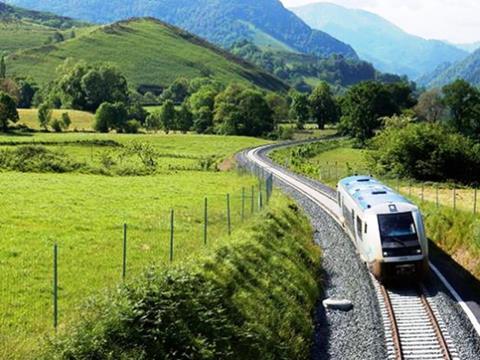
FRANCE: Thales has joined forces with a group of companies and the Nouvelle-Aquitaine Regional Council to develop innovative digital signalling and operations with a view to cutting the cost of running trains on lightly-used rural lines.
Partner companies in the Thales-led Nouvelle Signalisation Ferroviaire Frugale consortium are GeoSAT, Setec Ferroviaire and Clearsy.
The NS2F project has secured €7∙16m in funding from the Comité France 2030 mission. This was launched in October 2021 by President Macron to prepare the country for the future using targeted investment for relevant schemes. The consortium has opened contract discussions with the Agency for Ecological Transition and aims to complete the project in three years.
To achieve its objective the consortium will draw on technologies and expertise available through its member companies:
- platform-agnostic, autonomous train positioning and odometry without trackside infrastructure (Thales);
- cyber-secured data transmission via public telecommunications networks (Thales);
- high-density digital terrain mapping (GeoSAT);
- formal methods of generating safety data (Clearsy);
- a tablet-based supervision and operations interface for drivers (Setec Ferroviaire and Thales)
- integrated surveillance of level crossings (Thales and Nouvelle-Aquitaine Regional Council);
- network surveillance using sensors mounted on rail vehicles (GeoSAT, Nouvelle-Aquitaine Regional Council and Thales).
Thales says that the technology ‘will be fully interoperable with the core network and promises to reduce investment and operating costs by more than 30%’. Apart from reviving rural railways, it will improve safety, ‘especially at level crossings’, the company said.
Announcing the project on November 8, Amaury Jourdan, Chief Technical Officer at Thales Ground Transportation Systems, said that ‘the innovative systems we are developing together will revitalise France’s low-density rail lines and put us at the cutting edge of technology globally’.
The NS2F consortium is already working with national operator SNCF on the €90m Innovative Light Train project which was formally launched September; this aims ‘to reshape the mobility landscape throughout France’ and revitalise 12 000 km of low-density branch lines and other routes, many of which have been neglected to the extent that they are neither economically viable nor appealing to passengers. That project is due to run until 2025-26.
Nouvelle-Aquitaine Regional Council is meanwhile starting to implement the €65m Ferrocampus initiative to develop a railway education and industrial training site at Saintes in Charente-Maritime. Launched in 2020, this entails the construction of a dedicated facility on land owned by SNCF. It will include two engineering schools, a ‘digital cluster’ for innovation work and a laboratory with its own tracks for research on experimental vehicles. Opening is planned in 2025.

















